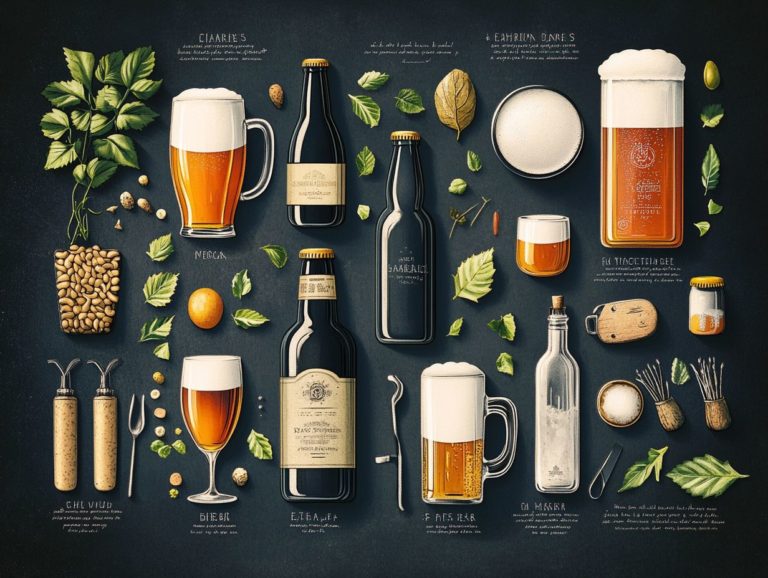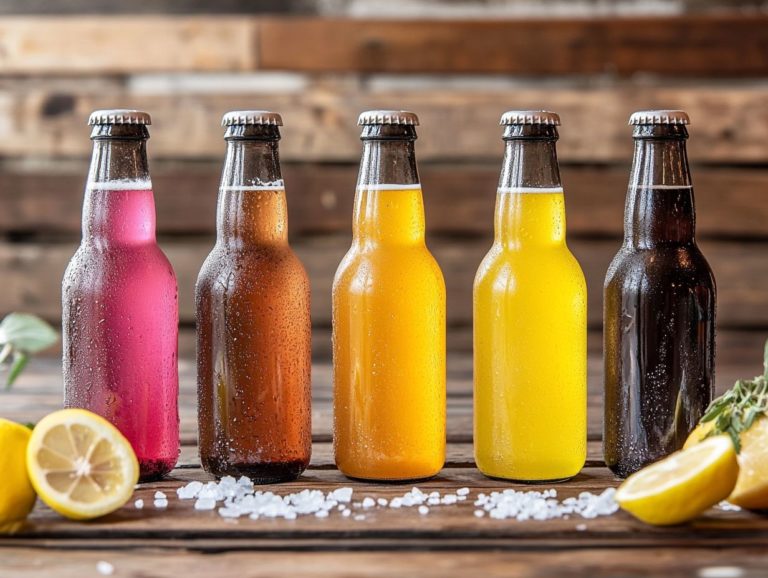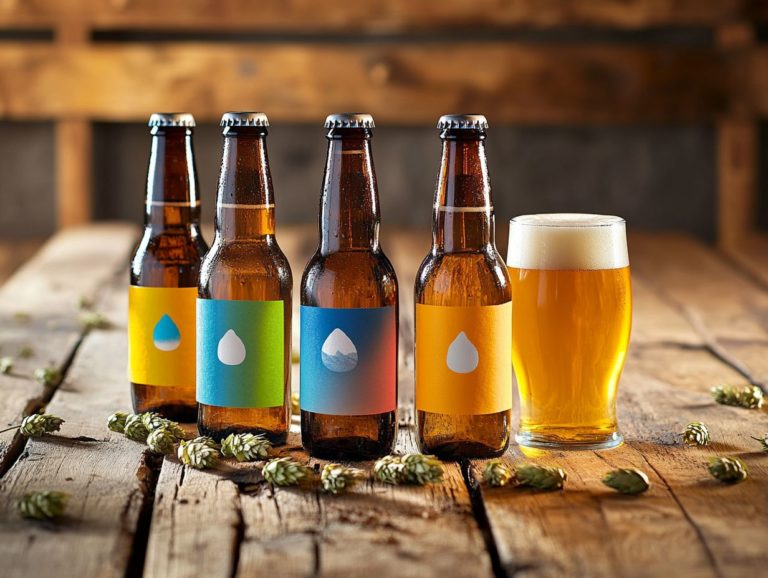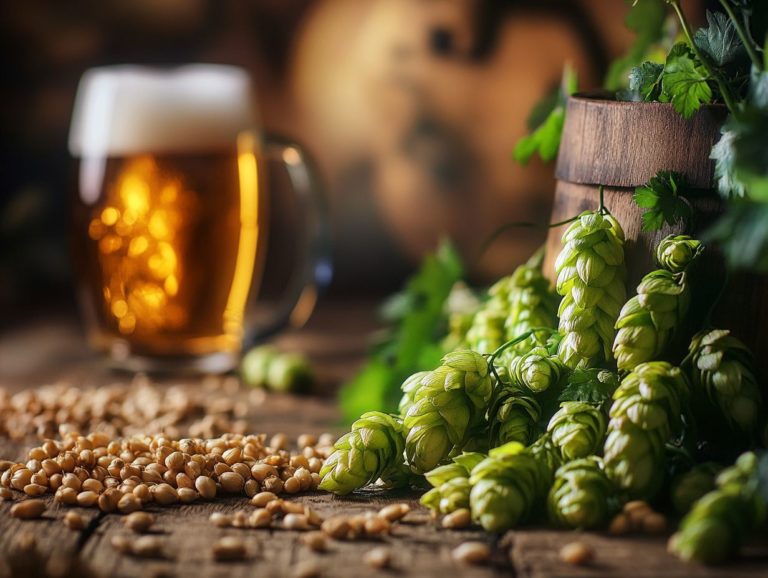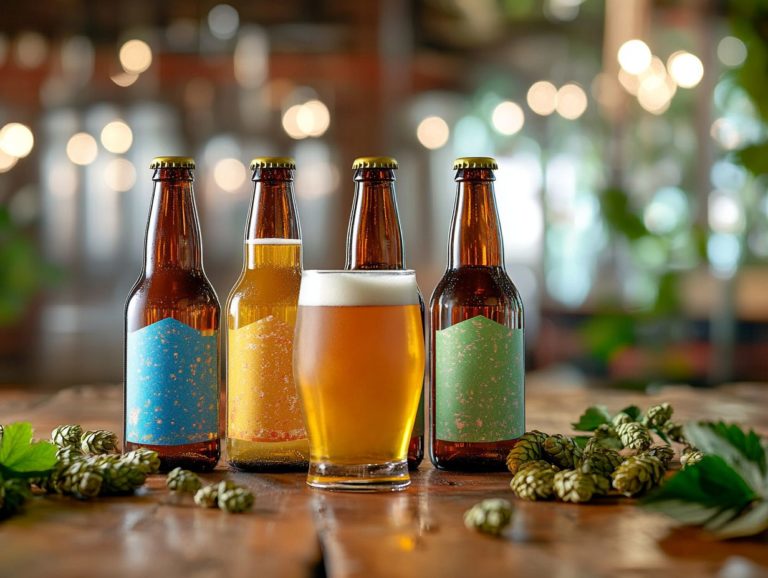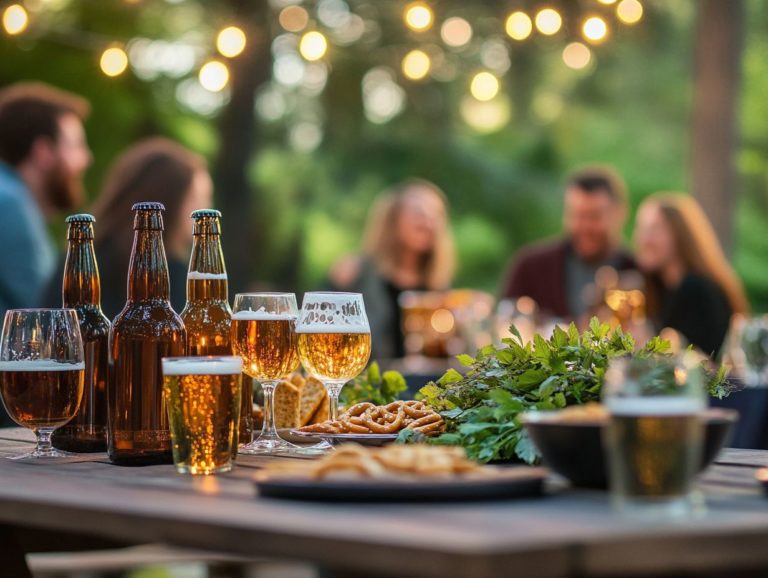The Art of Brewing Brown Ales
Brown ales, with their deep, inviting hues and intricate flavors, hold a special place in the hearts of beer enthusiasts. Their defining characteristics encompass not only their appearance but also their aroma and unique mouthfeel. Each brew is a testament to brewing mastery.
The brewing process involves specific ingredients and fermentation techniques that shape their distinct profiles. Explore popular styles, including English, American, and Belgian brown ales, and discover essential tips for crafting your perfect batch. Whether you are a homebrew enthusiast or a commercial brewer, there s something here for you.
Whether you re a seasoned brewer or simply intrigued by this delightful style, you will find captivating insights. From premium ingredients to advanced brewing equipment, creating brown ales is an exhilarating journey that every beer lover should experience!
Contents
Key Takeaways:
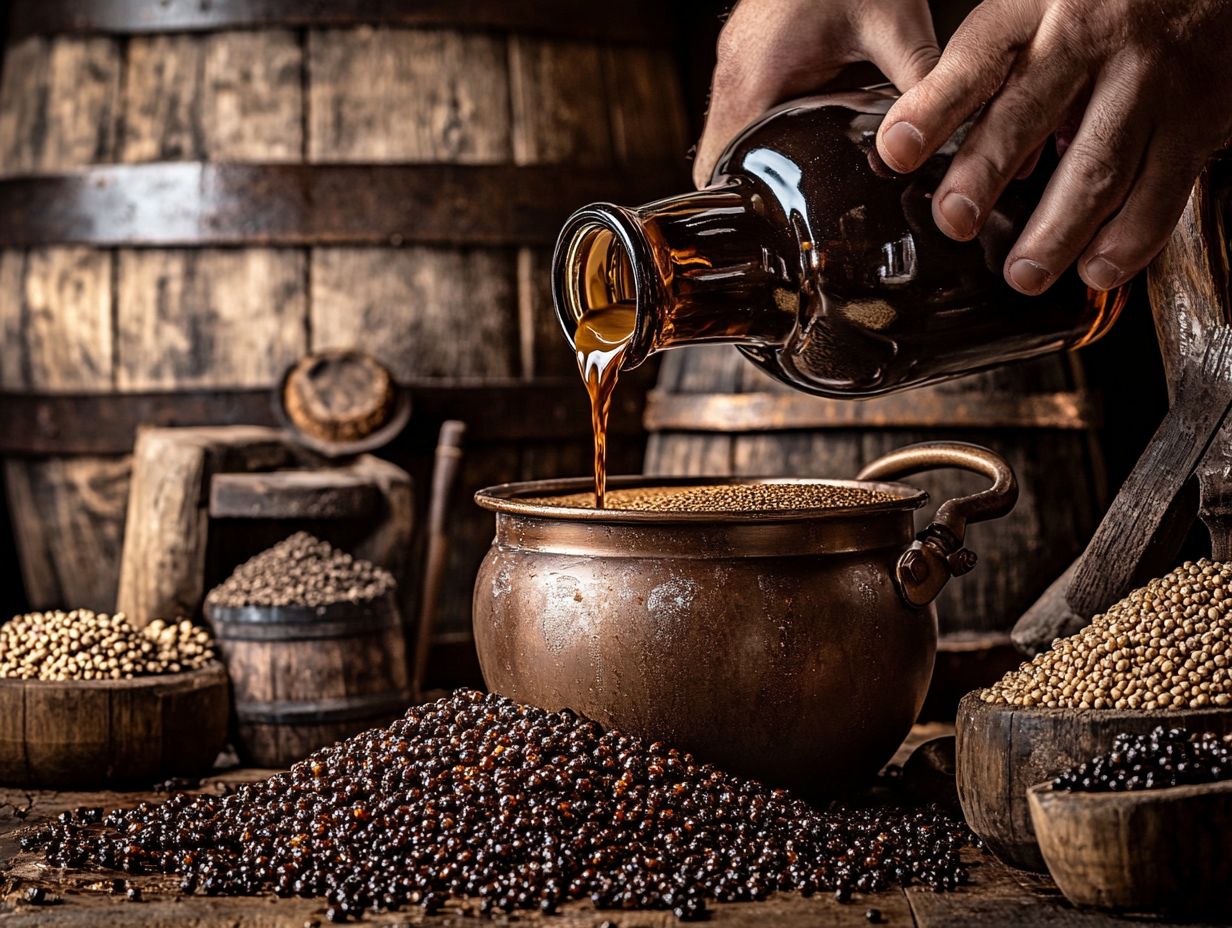
- Brown ales are characterized by their unique appearance, aroma, flavor, and mouthfeel, often showcasing a blend of nutty, earthy, and caramel notes.
- The brewing process for brown ales involves carefully selecting ingredients, proper mashing and boiling, fermentation, and aging.
- English, American, and Belgian styles are popular variations of brown ales, each with their own distinct characteristics.
The Characteristics of Brown Ales
Brown ales represent a captivating niche within the craft beer realm. They are renowned for their rich color and complex flavor profiles. Expect a beautifully balanced mouthfeel that can range from nutty and earthy to sweet and caramel-like.
The brewing process of these ales involves artistry and precision, reflecting the brewer’s passion and creativity. These ales are celebrated for their versatility and are crafted with high-quality ingredients like malts and hops.
They come in various styles across different breweries, including both English and American brown ales. Notable breweries like Samuel Smith and Bell’s Brewery have significantly contributed to the popularity of this style.
Temperature control and careful selection of yeast are crucial in the brewing process. This ensures that the final product exemplifies superior craftsmanship and quality. Tools and equipment, such as those offered by CraftMaster Stainless, play a pivotal role in achieving consistency and precision in every batch.
The result is an immersive drinking experience that resonates with both novices and seasoned beer enthusiasts alike.
Appearance
The appearance of brown ales is truly distinctive. They often display a deep amber to rich brown color that captivates your attention as a beer lover. This visual appeal is a testament to the quality and craftsmanship invested in each production cycle.
This enticing hue comes from the roasted and caramel malts used during brewing, adding layers of complexity to the beer. When held up to the light, you might notice varying degrees of clarity anywhere from slightly hazy to brilliantly clear depending on the filtration methods applied.
In contrast to lighter styles like pale ales, brown ales exude a more robust and inviting look. You’ll likely be impressed by the head retention, which usually forms a creamy, tan foam that lingers gracefully, enhancing the overall visual allure. This luxurious cap elevates aesthetics and frames the delightful aromas wafting from the glass.
Aroma
The aroma of brown ales presents a delightful blend of roasted malts, caramel, and delicate hop notes. This inviting bouquet elevates your drinking experience. The careful balance of ingredients and brewing techniques results in a superior product that beer lovers cherish.
This aromatic symphony often originates from the selection of specialty malts, such as chocolate and crystal, which contribute rich, nutty, and toasty scents. Elements come together in perfect harmony, creating a complex profile that may evoke memories of freshly baked bread or luscious toffee.
The use of specific hops, typically applied in smaller quantities to preserve the malt-forward character, adds an elegant layer of floral or citrus notes. Techniques like dry hopping can refine the final aroma, allowing the brewer to create a uniquely inviting scent that captivates the senses.
Curious about how to brew your own brown ale? Let s dive into the essentials!
In conclusion, brown ales offer a unique and rich craft beer experience. Whether you re exploring their varieties or trying your hand at brewing, there s a world of flavor waiting for you. Visit your local brewery or gather your ingredients to start your brewing adventure!
Flavor
The flavor of brown ales is a delightful symphony, richly layered with nutty, caramel, and chocolate notes. This is harmonized by a mild bitterness from hops that perfectly balances the sweetness.
The complexity of flavors in each sip is a true reflection of the brewer’s skill and dedication. With the first sip, you ll likely notice the toasty malt characteristics that serve as the backbone of these exquisite brews. Subtle hints of dark fruit weave their way into the experience.
It s worth noting that the artisanal choices made by esteemed breweries, such as Samuel Smith s and Bell’s Brewery, beautifully showcase the diversity within this category. For instance, the incorporation of dark malts deepens the flavor profile, while specific yeast varieties contribute unique flavor notes.
The interplay of ingredients and various fermentation methods ultimately crafts each brew’s individual taste experience, transforming brown ales into a nuanced adventure for any discerning beer enthusiast.
Mouthfeel
The mouthfeel of brown ales typically presents a smooth and medium-bodied sensation, offering a comforting experience. It can shift from creamy to slightly dry, depending on the carbonation levels.
This subtle variation is essential in elevating your overall drinking experience. Achieving the perfect viscosity often hinges on specific brewing techniques. Incorporating crystal malts lends a velvety texture and a touch of sweetness.
Fine-tuning the fermentation process significantly impacts the beer’s carbonation, influencing how it interacts with your palate. For example, naturally carbonated brown ales may feel softer and fuller, while a higher carbonation can provide a refreshing crispness.
Ultimately, these nuanced factors play a pivotal role in how you perceive and savor these richly flavored brews. They encapsulate the very essence that makes brown ales a cherished choice among beer enthusiasts.
The Brewing Process for Brown Ales
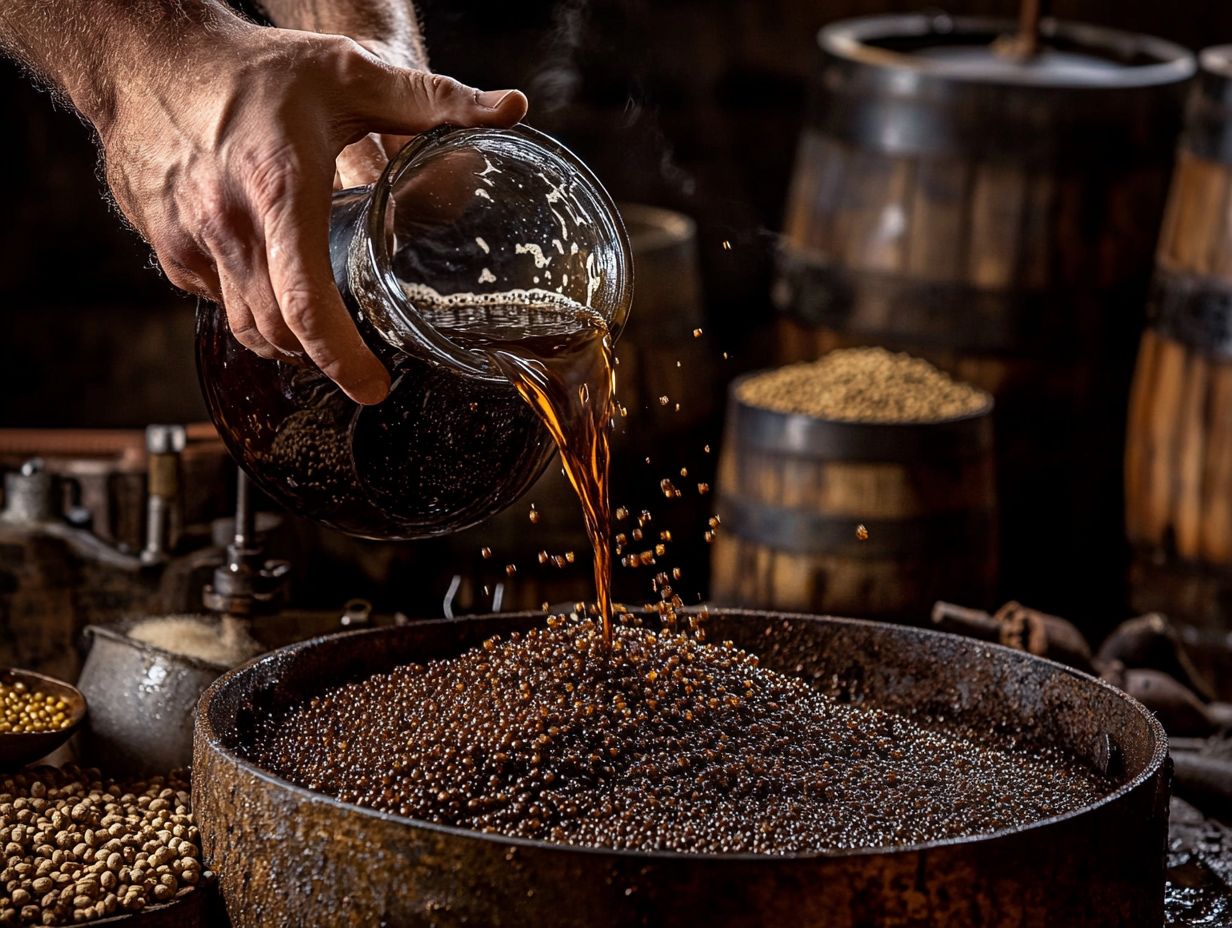
The brewing process for brown ales is a meticulous journey that begins with your selection of premium ingredients. Emphasizing high-quality malts and hops adds depth to the beer’s color and flavor.
Each step, from mashing to boiling to fermentation, requires careful attention to detail. This ensures superior quality and consistency in every batch. You ll find that temperature control is crucial during mashing and boiling, as it directly influences the extraction of sugars from the wort. This ensures you achieve a balanced and rich taste profile.
As you move into the fermentation stage, the careful introduction of yeast is key. This allows the ale’s character to develop fully. Finally, during the bottling and aging phases, you ll see how these steps culminate in the overall quality and craftsmanship that define an exceptional brown ale.
Ingredients
The ingredients you choose in crafting brown ales are absolutely essential. A harmonious blend of specialty malts, aromatic hops, and specific yeast strains come together to create a truly unique flavor profile.
Experimenting with different malts and hops, such as Crystal 60 or US-05 yeast, allows for creativity and customization in each brew. Different types of malts, like chocolate malt and crystal malt, impart rich caramel, toasty, and nutty nuances that define the character of brown ales.
By incorporating Munich and Maris Otter malts, you add depth and enhance the overall malt profile with delightful notes of biscuit and toffee.
On the hop side, it s the subtle varieties, like Fuggle or East Kent Goldings, that gracefully accentuate the aroma without overwhelming the palate. The selection of yeast is equally critical during fermentation. Specific strains can influence not only the alcohol content but also flavor elements, like fruity or spicy notes.
This means each brewed batch carries its distinct essence, shaped by your thoughtful choices as a brewer.
Mashing and Boiling
Mashing occurs between 150 F and 160 F (65 C to 71 C). Enzymes called alpha and beta amylase are activated to convert starches into fermentable sugars, impacting flavor and texture. Precision during these stages is critical, as it directly affects the quality and flavor of your brown ale.
Once mashing is complete, you heat the mash to a boil typically around 210 F (99 C) and introduce hops. This stage does more than add bitterness and aroma; it also sterilizes the wort, preparing it for fermentation while contributing essential oils that enhance the beer’s complexity. High-quality brewing equipment ensures consistency and precision at this stage, making it an investment in your brew’s excellence. With each step, you re crafting a beer that showcases your expertise and attention to detail.
Fermentation
Experience the magic as yeast transforms your brew into a delightful beverage, converting sugars extracted during mashing into alcohol and carbon dioxide. The choice of yeast, such as the popular US-05 strain, and maintaining an optimal fermentation environment are crucial in achieving desired results.
The fermentation process is pivotal in shaping the character of the final product; different yeast strains impart unique flavors and aromas. Typically, ale yeasts thrive in a cozy temperature range of 65 to 75 degrees Fahrenheit, where their activity peaks. Lower fermentation temperatures slow things down and result in cleaner profiles, while higher temperatures introduce delightful fruity esters and phenolic compounds.
This meticulous timing is essential, influencing both alcohol content and complexity of flavors. It contributes to the rich, malty backbone and subtle nutty undertones that define brown ales. Every decision you make during fermentation affects the quality of your brew, crafting a beer that s uniquely yours and full of character, much like the iterations seen in CraftMaster Stainless brewing recipes.
Bottling and Aging for Durability
Bottling and aging are the final, essential steps in brewing brown ales, allowing your brew to mature and develop its unique character before it graces your palate.
The bottling process starts with meticulous sanitation of all equipment since you want to avoid unwanted bacteria spoiling your carefully crafted flavors. Once everything is sanitized, transfer the brown ale into bottles, adding a precisely measured amount of sugar to promote carbonation. This step is crucial; the right sugar levels not only influence mouthfeel and fizziness but also enhance the overall profile of your beer.
Once sealed, store the ales in optimal conditions typically in a cool, dark place where the aging process can take its time. During this phase, flavors from various ingredients meld and mature, leading to a refined complexity that elevates your drinking experience.
Remember, proper storage conditions are vital. Fluctuations in temperature can alter the intended flavor profile, underscoring the importance of careful monitoring throughout the aging process.
Popular Styles of Brown Ales
Popular styles of brown ales present a fascinating array of flavors and characteristics. Take American brown ale, for instance; it typically boasts a hop-forward profile that tantalizes the palate.
In contrast, English variations invite you into a more malt-centric experience, rich with depth and warmth. Each style is a testament to the regional brewing traditions, beautifully showcasing the creativity and craftsmanship of breweries committed to perfecting the art of brown ale.
English Brown Ale
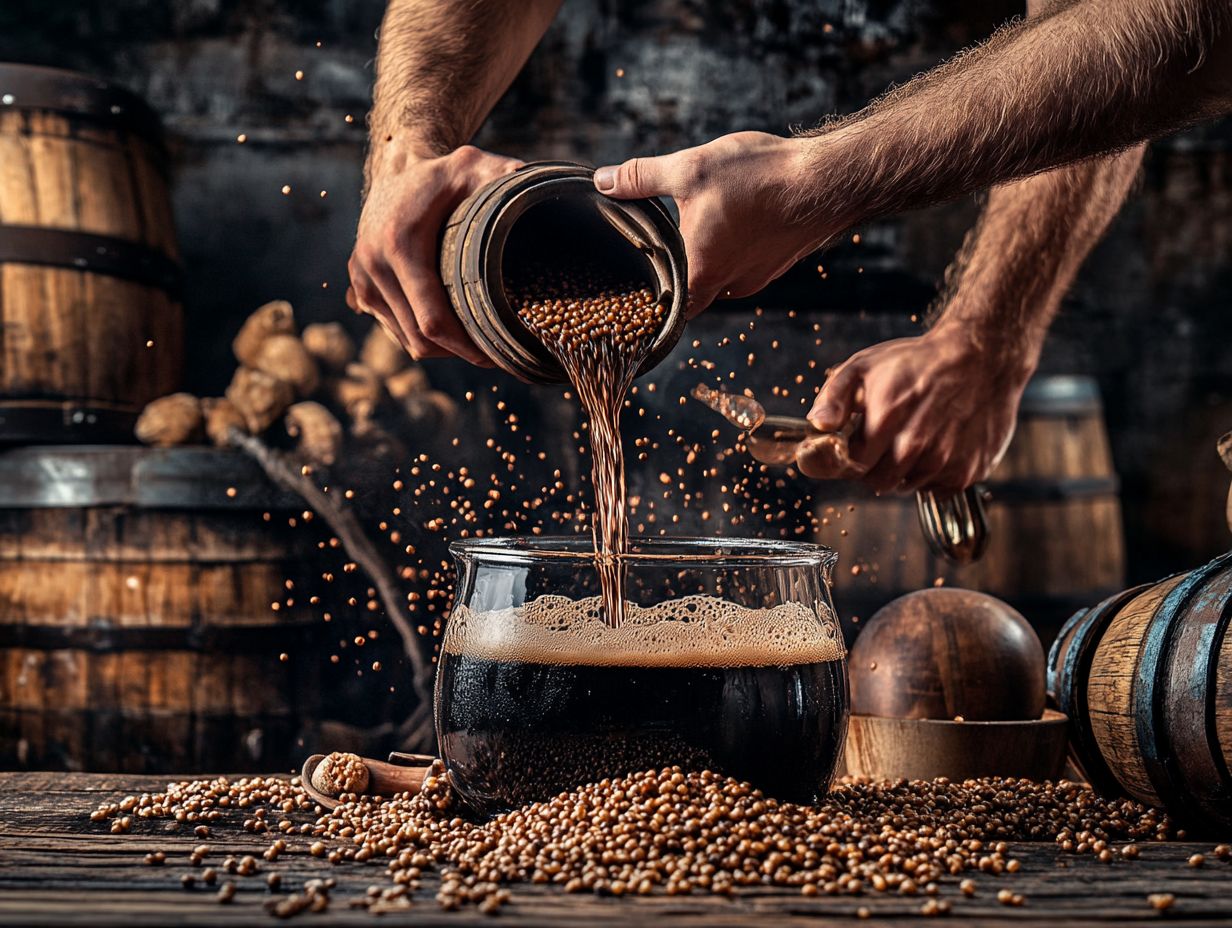
English brown ale is a timeless style that is celebrated for its malty sweetness and rich caramel flavor profile, typically achieved through the use of crystal malts and a meticulously balanced hop selection.
In addition to its distinctive malt characteristics, you ll find delightful notes of toffee, dark fruit, and nutty undertones. These elements make it a delightful experience for a wide range of palates. The aroma invites you in, reminiscent of freshly baked bread, with subtle hints of chocolate and caramel wafting in the air.
Traditional brewing practices are essential in crafting this ale, relying on a brewing technique where yeast rises to the top during fermentation and the careful selection of English hops such as Fuggles and East Kent Goldings. The inclusion of earthy ingredients, combined with the malts, creates a harmonious blend that defines the essence of this beloved beverage, solidifying its status as a staple in many pubs across England.
American Brown Ale
American brown ale typically presents a more pronounced hop character compared to its English counterpart, resulting in a delightful interplay between roasted malt flavors and a hoppy finish.
This style often showcases a diverse array of ingredients, including caramel and chocolate malts, which lend rich, nutty characteristics to the brew. When you indulge in an American brown ale, you’ll notice the influence of American-grown hops. These introduce unique citrus and pine notes that harmonize beautifully with the malt profile, crafting a balance that is both intricate and satisfying.
Brewing techniques like dry hopping and the use of various yeast strains elevate the flavor dynamics to new heights. This innovative approach reflects the evolution of brewing in the United States, allowing you to explore a spectrum of profiles that vary in the taste and smell, thus setting American brown ales apart in the ever-expanding landscape of craft beer.
Belgian Brown Ale
Belgian brown ale stands out with its intricate flavor profile, often inviting you to savor dark fruit notes, a robust malt backbone, and a delicate spiciness from the unique yeast strains employed during fermentation.
As you indulge in this distinctive ale, you’ll encounter flavors of caramel, figs, and raisins, all seamlessly entwined with a gentle sweetness reminiscent of toffee. The brewing traditions of Belgium are deeply rooted in the use of traditional yeast, which imparts fruity esters and spicy phenols, enhancing the complexity of every sip.
Typically, this beer undergoes a warm fermentation process, allowing the yeast characteristics to thrive and resulting in a beautifully rounded mouthfeel. With each glass, you’ll experience the subtle interplay between malt and yeast, offering you a glimpse into the artistry of Belgian brewing and a celebration of its rich history and artisan techniques.
Tips for Brewing the Perfect Brown Ale
Crafting the perfect brown ale is an exciting journey that combines art and science, where every detail matters. You’ll want to pay meticulous attention to selecting high-quality ingredients, skillfully controlling the fermentation process, and creating optimal aging conditions.
This careful approach is essential for achieving the best flavor and quality in your brew.
Choosing the Right Ingredients and Recipe
Selecting the right ingredients is essential for crafting a remarkable brown ale, as the choice of specific malts, hops, and yeast strains significantly influences the beer’s final flavor and aroma.
- The selection of malts is particularly vital, forming the backbone of your brew and contributing to its color and rich, nutty flavors. For brown ales, caramel and chocolate malts are highly recommended; they offer a delightful sweetness and depth that enhance the overall complexity of your creation.
- Regarding hops, a moderate bitterness is all you need, but opting for varieties like Fuggle or East Kent Goldings can introduce earthy undertones that beautifully harmonize with the malts.
- Don t overlook the yeast strain; it plays a crucial role in fermentation, imparting fruity esters that complement the malt profile perfectly.
Each carefully chosen ingredient not only shapes the style of your beer but also dictates how appealing the final brew will be to fellow enthusiasts. Your careful attention to detail will make every sip a delightful experience for your fellow enthusiasts.
Controlling the Fermentation Process
Controlling the fermentation process is essential for achieving the flavor profile you desire in brown ales. By carefully managing temperature and yeast activity, you can ensure consistent and high-quality results.
To effectively manage fermentation, maintain a temperature range between 65 F and 72 F. This encourages the yeast to produce a delightful array of esters and phenols. Monitor the fermentation timing closely; allowing for a longer fermentation period can lead to greater flavor complexity and smoothness.
By fine-tuning these factors, you can significantly enhance not only the aroma but also the mouthfeel of your brew. The interplay between yeast health and environmental conditions ultimately dictates the final characteristics of your beer. Regularly check specific gravity and taste profiles throughout the process.
Aging and Serving Recommendations
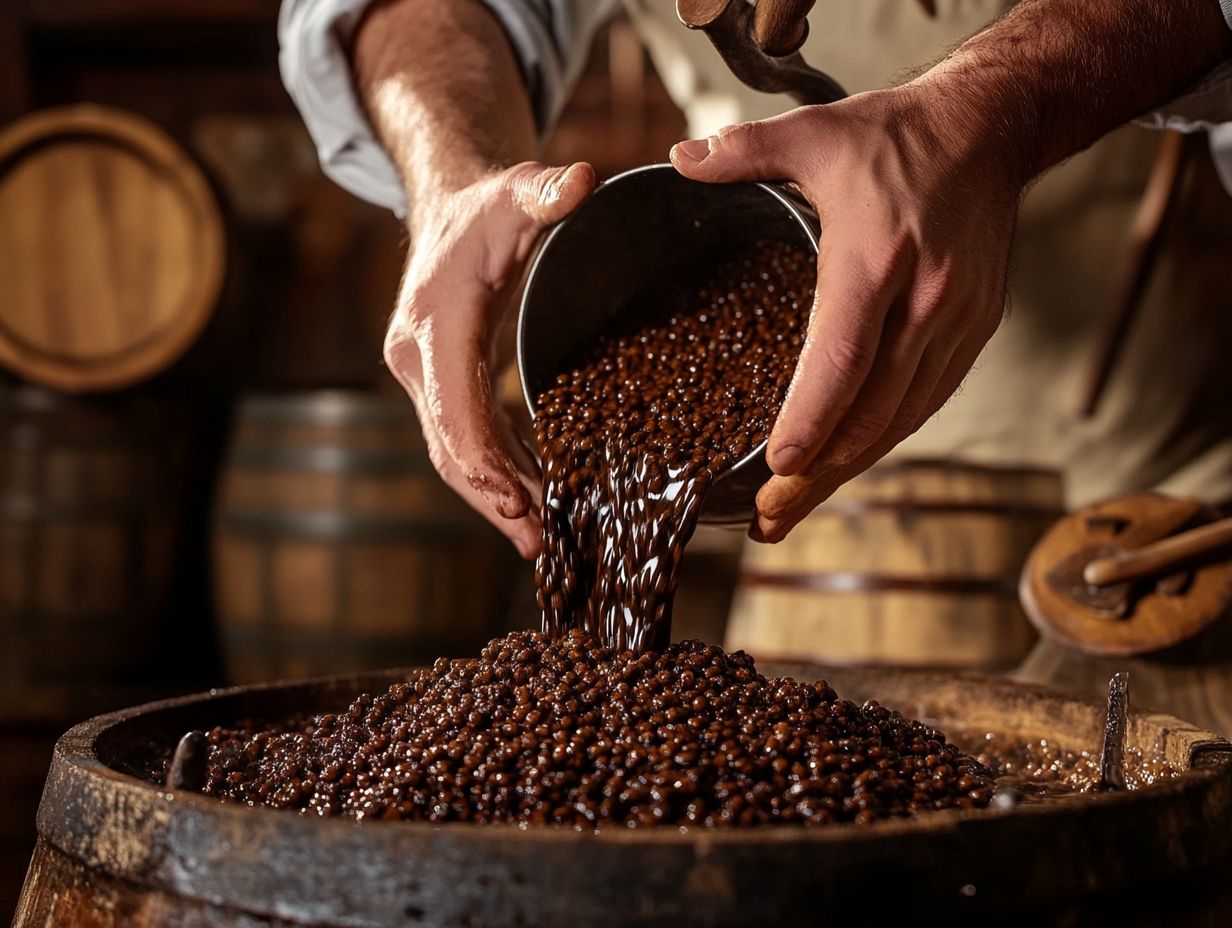
Aging brown ales properly can significantly elevate their flavor complexity. You ll want to pay attention to optimal storage conditions and serving practices to truly maximize your tasting experience.
To fully appreciate the depth of these rich brews, consider the environment in which you store them. A dark, temperature-controlled space, shielded from fluctuating conditions, is your best bet for ensuring that flavors develop harmoniously over time. As the years pass, you may find the sweet caramel and nutty notes becoming more pronounced, while the hoppy bitterness gradually subsides, resulting in a smoother, more balanced profile.
When it s time to serve, pouring your aged ale into a tulip glass can enhance its aromatic qualities, transforming each sip into a delightful experience. Aim to serve these ales above refrigerator temperature, allowing those nuanced flavors to unfold beautifully with every taste.
Frequently Asked Questions
What is The Art of Brewing Brown Ales?
The Art of Brewing Brown Ales is the process of creating a type of beer characterized by its brown color and malty flavor. It involves combining water, malted barley, hops, and yeast in a specific way to produce a unique and delicious brew.
What makes Brown Ales different from other types of beer?
Brown Ales set themselves apart from other types of beer through their distinct dark color and a balance of malt sweetness and hop bitterness. They also tend to have a lower alcohol content compared to other styles.
What are the key ingredients in brewing a Brown Ale?
The main ingredients in brewing a Brown Ale are water, malted barley, hops, and yeast. Some brewers may also add other ingredients such as spices, fruits, Crystal 60, or additional grains to add unique flavors to their brews. Breweries such as CraftMaster Stainless often utilize these ingredients.
What are the different styles of Brown Ales?
There are various styles of Brown Ales, including English Brown Ales, American Brown Ales, Belgian Brown Ales, and German Brown Ales. Among the English types, there are Southern English Brown Ale and Northern English Brown Ale. Each style has its unique characteristics and flavors, making them distinct from one another. Notable examples include Newcastle and Samuel Smith.
How long does it take to brew a Brown Ale?
The brewing process for a Brown Ale typically takes around 4-6 weeks. This includes fermentation, conditioning, and bottling. However, some brewers may choose to age their Brown Ales for longer periods to enhance the flavors. Common yeast strains like US-05 are often used during the fermentation process.
What food pairs well with a Brown Ale?
Brown Ales have a wide range of food pairing options due to their versatility in flavor. They pair well with roasted meats, grilled vegetables, hearty stews, and even chocolate desserts or cookies. The malty and slightly sweet flavors of a Brown Ale can complement and enhance the flavors of these dishes. Michael Jackson, the beer connoisseur, often highlighted the versatility of Brown Ales in his writings.
Ready to brew your own brown ale? Dive into the world of brewing and enjoy the rich flavors you’ve learned about!

